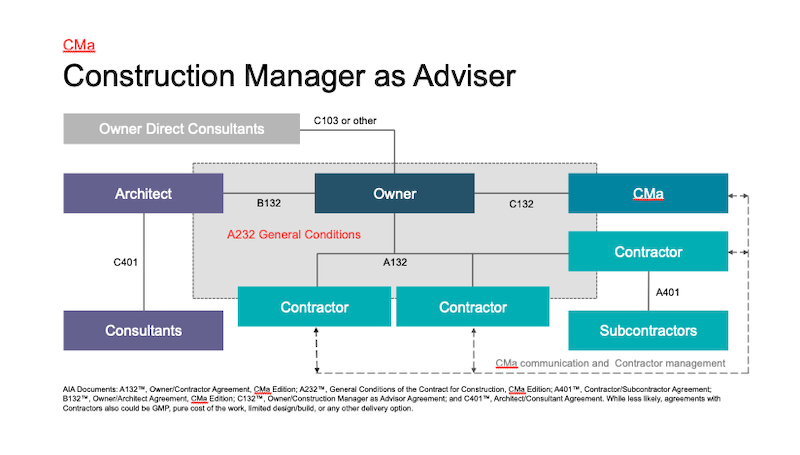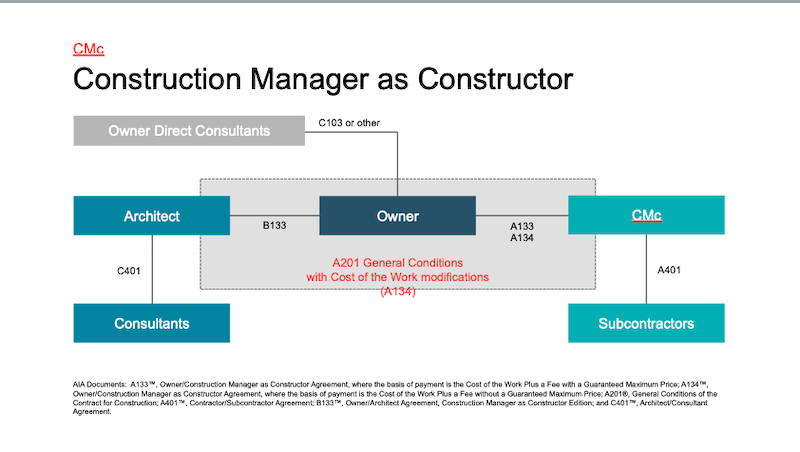On Nov. 15, the American Institute of Architects (AIA) plans to release its new and updated Construction Manager as Constructor (CMc) family of contract documents. Next February, the AIA will release its updated Construction Manager as Adviser (CMa) family of documents.
These documents get updated on a 10-year revision cycle.
The AIA divides its contract documents into nine families, organized by delivery method. These include families for design-bid-build (the most widely used contract model), design-build, and integrated project delivery, as well as contracts that specifically cover interiors, small projects, and digital practices. The design-bid-build document family was updated in 2017.
Under CMc, the Construction Manager comes on the project during the preconstruction phase to provide early collaboration. In the construction phase, the CM does the construction work, as if it were a General Contractor.
Under the CMa, the Construction Manager is also retained by the owner for early collaboration during the preconstruction phase. But the CMas don’t perform the construction work. The CMa documents are designed for complex projects with more than one prime contractor. During the construction phase, the CMa coordinates and manages the contractors, as well as providing cost estimating and other functions.
Susan Van Bell, Senior Director and Counsel – AIA Contract Documents Content, tells BD+C that the AIA solicited input from CM practitioners about revisions to the documents so that they’d better reflect current practices.
From those conversations, CMs suggested that one change they wanted was a way to tailor the document for the scope of preconstruction services without having the standard contract language be too restrictive.
Van Bell says the 2019 CMc revision addresses this issue by inserting “fill points” into the contract where more preconstruction details can be identified. The update also makes some edits to the standard preconstruction services scope.

A schematic of the family of documents for Construction Manager as Advisor.
The CMc documents now include insurance and bond exhibits, which had been added to the design-bid-build document family in its 2017 revision. Van Bell says there are also new exhibits for both the CMc and CMa documents that cover the role of the CM in sustainable projects.
The revised CMa documents clarify the CMa’s role in such areas as analyzing and coordinating the contractors’ schedules. The CMa is also the responsible party for managing a project’s digital information systems. “We clarified the communication process,” Van Bell says. The 2017 updates that required the establishment of protocols for digital data and BIM were carried into the CMc and CMa updates.
Related Stories
| Oct 13, 2014
Debunking the 5 myths of health data and sustainable design
The path to more extensive use of health data in green building is blocked by certain myths that have to be debunked before such data can be successfully incorporated into the project delivery process.
| Oct 13, 2014
Department of Agriculture launches Tall Wood Building Competition
The competition invites U.S. developers, institutions, organizations, and design teams willing to undertake an alternative solution approach to designing and building taller wood structures to submit entries for a prize of $2 million.
| Oct 12, 2014
AIA 2030 commitment: Five years on, are we any closer to net-zero?
This year marks the fifth anniversary of the American Institute of Architects’ effort to have architecture firms voluntarily pledge net-zero energy design for all their buildings by 2030.
| Oct 10, 2014
A new memorial by Zaha Hadid in Cambodia departs from the expected
The project sees a departure from Hadid’s well-known use of concrete, fiberglass, and resin. Instead, the primary material will be timber, curved and symmetrical like the Angkor Wat and other Cambodian landmarks.
| Oct 9, 2014
Regulations, demand will accelerate revenue from zero energy buildings, according to study
A new study by Navigant Research projects that public- and private-sector efforts to lower the carbon footprint of new and renovated commercial and residential structures will boost the annual revenue generated by commercial and residential zero energy buildings over the next 20 years by 122.5%, to $1.4 trillion.
| Oct 9, 2014
More recession-postponed design projects are being resurrected, says AIA
About three quarters of the estimated 700 firms that serve as panelists on AIA’s Architectural Billings Index (ABI) had delayed or canceled major design projects in response to recessionary pressures. Nearly one-third of those firms now say they have since restarted stalled projects.
| Oct 9, 2014
Steven Holl's 'intersecting spheres' scheme for Taipei necropolis gets green light
The schematic design has been approved for the 50 000-sm Arrival Hall and Oceanic Pavilion for the Taiwan ChinPaoSan Necropolis.
| Oct 9, 2014
Beyond the bench: Meet the modern laboratory facility
Like office workers escaping from the perceived confines of cubicles, today’s scientists have been freed from the trappings of the typical lab bench, writes Perkins+Will's Bill Harris.
| Oct 8, 2014
New tools for community feedback and action
Too often, members of a community are put into a reactive position, asked for their input only when a major project is proposed. But examples of proactive civic engagement are beginning to emerge, write James Miner and Jessie Bauters.
| Oct 8, 2014
Massive ‘healthcare village’ in Nevada touted as world’s largest healthcare project
The $1.2 billion Union Village project is expected to create 12,000 permanent jobs when completed by 2024.

















